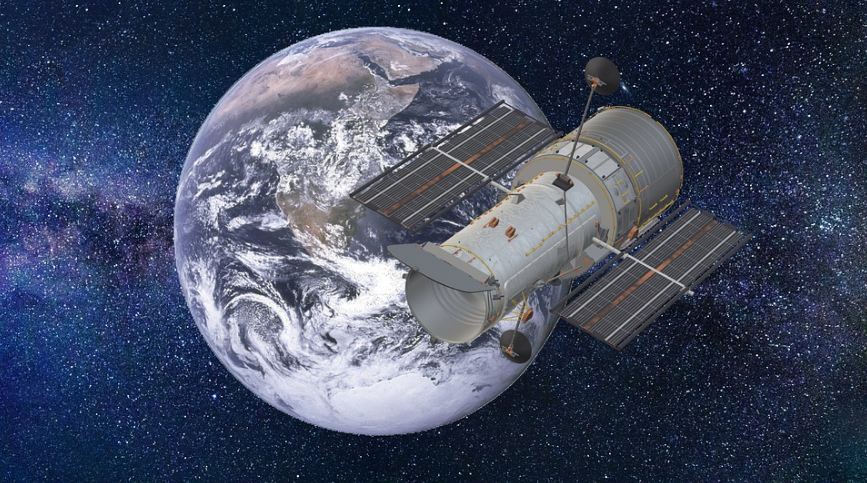A telescope is an instrument that is used to magnify and see objects that are not visible to the naked eyes. It uses lenses, mirrors, or sometimes a combination of the two. Most telescopes are used to see celestial bodies and objects in the night sky. Telescopes come in various sizes, uses, and different power. We have the Hubble Space Telescope, a reflector telescope, running along with the extraterrestrial vastness of space in outer space.
WHAT IS THE HUBBLE SPACE TELESCOPE
The Hubble Space Telescope was named after the American astronomer Edwin Hubble. Edwin Hubble was the first man to discover the celestial objects in our universe. He found the immense galaxies in our universe using the largest telescope of his time at the Mt. Wilson Observatory located in Pasadena, California.
Eventually, the Hubble Space Telescope became the first-ever major optical telescope that was set down in space. 1990 was the year when the Hubble Space Telescope was first ejected in space. 1990 was also the start of the significant discoveries and developments in astronomy. Scientists and researchers used the Hubble Space Telescope in examining the universe and the different celestial bodies and celestial objects it possesses.
The Hubble Space Telescope has a size of about 43.5 feet, a diameter of 14 feet, and approximately 10,886 kilograms. To see things in outer space, the Hubble Space Telescope consists of 94.5 inches in diameter primary mirror with a weight of 828 kg and a secondary mirror with a diameter of 12 inches and a weight of 12.3 kg. This telescope has a speed of approximately 27,300 kph, so it would take it around 95 minutes to complete one orbit. To function correctly, the Hubble Space Telescope gets energy from the Sun, making the Sun its main energy source.
THE FARTHEST DISTANCE THE HUBBLE TELESCOPE HAS SEEN
The Hubble Deep Field is, so far, the farthest thing the Hubble Space Telescope has ever seen. This Hubble Deep Field is an area in the Ursa Major constellation that contains hundreds and thousands of varieties of galaxies that astronomers have never seen before. This is the most in-depth view of our universe, approximately 10-15 billion lightyears away from Earth. Through the Hubble Deep Field discovery, about 3000 galaxies, including the youngest and the farthest of most galaxies, were caught sight of.
THE DISCOVERY OF THE FARTHEST INDIVIDUAL STAR
The Hubble Space Telescope was also the first telescope to discover the farthest individual star so far. This star is the MACS J1149+2223 Lensed Star 1, but it is commonly known as Icarus. The name Icarus was from the Greek mythological character, Icarus, who flew close to the Sun using his wings of feathers and wax that eventually melted. This star was a beaming dot located 9 billion lightyears away from Earth. This star’s distance should have been impossible to be seen even by the biggest and the greatest telescopes. Still, luckily, a huge cluster of galaxies warped the light coming from the star, magnifying Icarus for 2,000 times and bending towards the direction of the Earth, causing it to be visible to the Hubble Space Telescope. This gravitational lensing became a huge help in seeing Icarus, the farthest star. Gravitational lensing is like a natural lens. It is way better than the greatest of all the telescopes.
At first, astronomers thought this star was a supernova because of its very bright appearance. However, as they study this bright dot, they did not notice any change in temperature like a supernova would have, so they identified this star as a stable star. Icarus is a massive blue individual star that is way bigger and way hotter than the Sun. Although this star was shining brightly, it was probably dead. Blue supergiant stars could not be able to live long enough, like 9 billion years. It has most likely been dead for a couple of years already. Many suspicions were formulated on why Icarus is still shining brightly as ever. It is either this star formed as a black hole, or maybe it became a neutron star.
According to the scientists and astrophysicists, if they try looking deeper and harder enough, they might discover some of the earliest stars of the universe. Astronomers said that if the idea of gravitational lensing may be applied to future technologies like NASA’s James Webb Space Telescope, many stars like the Icarus, even farther and older, would be found.


